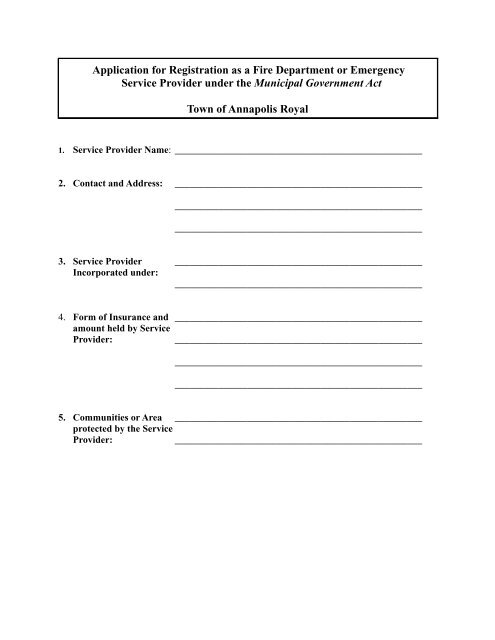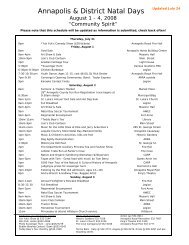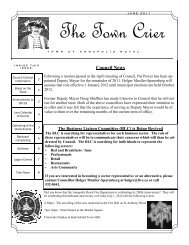Application for Registration as a Fire Department or Emergency ...
Application for Registration as a Fire Department or Emergency ...
Application for Registration as a Fire Department or Emergency ...
You also want an ePaper? Increase the reach of your titles
YUMPU automatically turns print PDFs into web optimized ePapers that Google loves.
<strong>Application</strong> <strong>f<strong>or</strong></strong> <strong>Registration</strong> <strong>as</strong> a <strong>Fire</strong> <strong>Department</strong> <strong>or</strong> <strong>Emergency</strong><br />
Service Provider under the Municipal Government Act<br />
Town of Annapolis Royal<br />
1. Service Provider Name:<br />
2. Contact and Address:<br />
3. Service Provider<br />
Inc<strong>or</strong>p<strong>or</strong>ated under:<br />
4. F<strong>or</strong>m of Insurance and<br />
amount held by Service<br />
Provider:<br />
5. Communities <strong>or</strong> Area<br />
protected by the Service<br />
Provider:
<strong>Application</strong> <strong>f<strong>or</strong></strong> <strong>Registration</strong> <strong>as</strong> a <strong>Fire</strong> <strong>Department</strong> <strong>or</strong> <strong>Emergency</strong><br />
Service Provider under the Municipal Government Act<br />
Nature of Services Provided:<br />
Town of Annapolis Royal<br />
Ple<strong>as</strong>e indicate the nature of <strong>Emergency</strong> Services provided and the level of service provided<br />
by circling the appropriate reference.<br />
6. <strong>Fire</strong> and <strong>Fire</strong> Related Emergencies Structural Defensive N/A<br />
7. Medical Emergencies Registered First Medical N/A<br />
Responder Assistance<br />
8. Vehicle Rescue Technician Operational Awareness N/A<br />
9. Water Rescue Technician Operational Awareness N/A<br />
10. Ice Rescue Technician Operational Awareness N/A<br />
11. Structural Collapse Technician Operational Awareness N/A<br />
12. Excavation Collapse Technician Operational Awareness N/A<br />
13. High Angle Rescue Technician Operational Awareness N/A<br />
14. Hazardous Material Technician Operational Awareness N/A<br />
15. Ground Search and Rescue Provider Assistance N/A<br />
16. Confined Space Entry Provider Assistance N/A<br />
17. Confined Space Rescue Provider Assistance N/A
<strong>Application</strong> <strong>f<strong>or</strong></strong> <strong>Registration</strong> <strong>as</strong> a <strong>Fire</strong> <strong>Department</strong> <strong>or</strong> <strong>Emergency</strong><br />
Service Provider under the Municipal Government Act<br />
Town of Annapolis Royal<br />
Ple<strong>as</strong>e refer to the “Evaluation of Services Provided and Level of Service”<br />
in<strong>f<strong>or</strong></strong>mation attached, in answering the following questions:<br />
18. Are there any limits on the level of service that will be provided in respect to any of<br />
the services checked above If so, ple<strong>as</strong>e indicate:<br />
19. Does the Service Provider have the equipment to per<strong>f<strong>or</strong></strong>m the services checked above<br />
20. Does the Service Provider have the training and experience necessary to provide the<br />
services checked above<br />
Date: Date:<br />
Signature and Name and Position<br />
of <strong>Emergency</strong> Service Provider<br />
Representative<br />
Signature and Name and<br />
Position of Municipal<br />
Representative
Date: Date:<br />
Signature and Name and Position<br />
of <strong>Emergency</strong> Service Provider<br />
Representative<br />
Signature and Name and<br />
Position of Municipal<br />
Representative<br />
Date:<br />
Signature and Name and Position<br />
of <strong>Emergency</strong> Service Provider<br />
Representative<br />
Evaluation of Services Provided and Level of Service <strong>f<strong>or</strong></strong> Use with<br />
<strong>Application</strong> <strong>f<strong>or</strong></strong> <strong>Registration</strong> <strong>as</strong> a <strong>Fire</strong> <strong>Department</strong> <strong>or</strong> <strong>Emergency</strong> Services<br />
Provider under the Municipal Government Act
In<strong>f<strong>or</strong></strong>mation From the Office of the <strong>Fire</strong> Marshall<br />
The registration of a fire department <strong>or</strong> emergency services provider is a replacement <strong>f<strong>or</strong></strong> the fire<br />
wards system. The process recognizes that fire departments may carry on a wider variety of<br />
services then under the previous Act.<br />
The following is a direct quote from National <strong>Fire</strong> Protection Association Standard 1500:<br />
“Spelling out the specific parameters of services to be provided allows the fire<br />
department to plan, staff, equip, train, and deploy members to per<strong>f<strong>or</strong></strong>m these duties. It<br />
also gives the governing body an accounting of the costs of services and allows it to<br />
select those services they can af<strong>f<strong>or</strong></strong>d to provide. Likewise, the governing body should<br />
identify services it cannot af<strong>f<strong>or</strong></strong>d to provide and that it cannot register the department<br />
to deliver.”<br />
There are a number of fire departments who have expressed concern that they could be prevented<br />
from attending at emergencies in their communities. The registration should not there<strong>f<strong>or</strong></strong>e be an<br />
all <strong>or</strong> nothing situation. The responding department may not have the training, equipment <strong>or</strong><br />
command system to fully handle the situation. The department may, however, be able to provide<br />
<strong>as</strong>sistance to the victims until m<strong>or</strong>e qualified help does arrive. This level of service can be<br />
indicated upon registering, in letter <strong>f<strong>or</strong></strong>m <strong>or</strong> on the registration <strong>f<strong>or</strong></strong>m, by a note indicating a limit<br />
on the level of service to be provided, <strong>or</strong> by a note stating what, in the definitions provided<br />
below, will not be provided.<br />
To <strong>as</strong>sist the fire service and the municipal units, the Office of the <strong>Fire</strong> Marshal h<strong>as</strong> developed a<br />
registration <strong>f<strong>or</strong></strong>m that includes a checklist <strong>f<strong>or</strong></strong> services and level of abilities. This checklist w<strong>as</strong><br />
developed with the <strong>as</strong>sistance of the <strong>Fire</strong> Officers Association direct<strong>or</strong>s. The use of this <strong>f<strong>or</strong></strong>m is<br />
not compuls<strong>or</strong>y. Each Town may develop its own registration process in acc<strong>or</strong>dance with the<br />
Municipal Government Act, although it is noted that it is the desire of the fire service advis<strong>or</strong>y<br />
group that there should be one common system rather than 55.<br />
The Office of the <strong>Fire</strong> Marshal will not be evaluating fire departments; the registration<br />
process is between the Town and the fire department.<br />
The standards selected are from the National <strong>Fire</strong> Protection Association 1500 standard <strong>f<strong>or</strong></strong><br />
<strong>Fire</strong>fighter Occupational Health and Safety. The key to this standard is that, “ no activity is<br />
undertaken unless the benefit out weighs the risk,” <strong>f<strong>or</strong></strong> example, items such <strong>as</strong> a minimum fourperson<br />
crew <strong>f<strong>or</strong></strong> interi<strong>or</strong> attack should be followed except where a rescue of someone inside the<br />
building is possible. The NFPA 1500 document should be the c<strong>or</strong>ner stone upon which each fire<br />
department attempts to meet the highest standard of safety. There are sections such <strong>as</strong> physical<br />
fitness requirements and recruiting that may require a different approach by the fire department.<br />
Definition of Terms Used in the <strong>Registration</strong> F<strong>or</strong>m<br />
6. - <strong>Fire</strong> and <strong>Fire</strong> Related Emergencies:<br />
Structural: means the activities of rescue, fire suppression, and property conservation in<br />
buildings, enclosed structures, vehicles, vessels, <strong>or</strong> like properties that are involved in a
fire <strong>or</strong> emergency situation. <strong>Department</strong>s should have firefighters trained to NFPA 1001,<br />
protective personal equipment, down alarms, accountability system, adequate water<br />
supply, pumping capacity and an incident command system. <strong>Department</strong>s should also<br />
have proper training and protective clothing <strong>f<strong>or</strong></strong> wild land fires in acc<strong>or</strong>dance with the<br />
<strong>Department</strong> of Natural Resources’ provincial standard. Shipboard firefighting, if<br />
provided, should be carried out following the NFPA standard 1405 1996 Edition Guide<br />
<strong>f<strong>or</strong></strong> Land-B<strong>as</strong>ed <strong>Fire</strong> Fighters Who Respond to Marine Vessel <strong>Fire</strong>s. Protection of Aircraft<br />
at airp<strong>or</strong>ts by volunteers, if provided, should be in acc<strong>or</strong>dance with Transp<strong>or</strong>t Canada<br />
guidelines.<br />
Defensive: means actions that are intended to control a fire by limiting its spread to a<br />
defined area, avoiding the commitment of personnel and equipment to dangerous are<strong>as</strong>.<br />
Defensive operations are generally per<strong>f<strong>or</strong></strong>med from the exteri<strong>or</strong> of structures and are<br />
b<strong>as</strong>ed on a determination the risk to personnel exceeds the potential benefits of offensive<br />
actions. <strong>Fire</strong> departments without the ability to carry out structural firefighting may<br />
register <strong>as</strong> providing property protection through defensive strategies. Rescue may be<br />
undertaken if the benefit warrants the risk. <strong>Department</strong>s should have proper training and<br />
protective clothing <strong>f<strong>or</strong></strong> wild land fires in acc<strong>or</strong>dance with the <strong>Department</strong> of Natural<br />
Resources’ provincial standard.<br />
N/A: means the department does not respond to these calls.<br />
7. - Medical Emergencies: response to known medical emergencies.<br />
Registered First Responder: means responders registered with the <strong>Department</strong> of<br />
Health through EHS first responder program and respond to medical calls <strong>or</strong> provide<br />
medical <strong>as</strong>sistance at the scene of an incident.<br />
Medical Assistance: means responders who have standard <strong>or</strong> emergency first aid and<br />
respond to medical emergencies <strong>or</strong> provide medical <strong>as</strong>sistance at a response incident.<br />
Equipment includes a first aid kit.
8 to 14 - The following terminology is used in respect to vehicle rescue, water rescue, ice<br />
rescue, structural/excavation collapse and high angle rescue:<br />
These activities should be carried out in acc<strong>or</strong>dance with NFPA 1670 Standard <strong>f<strong>or</strong></strong> Rescue,<br />
1999. Generally, these terms mean:<br />
Technician: First responder at the technicians level are those persons who respond,<br />
<strong>as</strong> either initial call out <strong>or</strong> <strong>as</strong> a mutual aid response to contain and control the incident.<br />
This level of service usually will provide a high degree of intervention.<br />
Operations: First responders at the operations level are those persons who respond <strong>as</strong><br />
the initial response to an incident <strong>f<strong>or</strong></strong> the purpose of protecting nearby persons, the<br />
environment, <strong>or</strong> property from the effects of the incident. First responders at the<br />
operations level are expected to respond in a defensive f<strong>as</strong>hion to control, prevent a<br />
w<strong>or</strong>sening of the incident and provide services within their capabilities.<br />
Awareness: First responders at the awareness level are those persons who, in the<br />
course of their n<strong>or</strong>mal duties, could be the first on the scene of an emergency. First<br />
responders at the awareness level are expected to recognize the situation, call <strong>f<strong>or</strong></strong><br />
trained personnel, secure the area and provide minimum intervention.<br />
Refer to Standard 1670, but, <strong>f<strong>or</strong></strong> example, these terms mean:<br />
8. - Vehicle Rescue: means removal of victims from a vehicle following an accident. This may<br />
require elab<strong>or</strong>ate <strong>or</strong> simple tools and knowledge depending upon the incident. The first<br />
responder should be aware of the department’s abilities and when it is necessary to request a<br />
higher level of service.<br />
Technician: properly maintained complete set of heavy hydraulic extrication equipment and<br />
<strong>as</strong>sociated spreaders, cutters, rams, chains, cribbing, etc. and trained <strong>as</strong> a team to use the<br />
equipment, recognize hazards and protect the victim.<br />
Operations: properly maintained hand tools, manual hydraulic tools, air tools, and trained<br />
<strong>as</strong> a team to use the equipment, recognize hazards and protect the victim.<br />
Awareness: Does not have the equipment <strong>f<strong>or</strong></strong> extrication but does respond to mot<strong>or</strong> vehicle<br />
accidents.
9. - Water Rescue: means rescue of individuals from rivers, lakes, ponds, and may include body<br />
retrieval.<br />
Technician: survival suits, water rescue kit, if diving is provided-- appropriate equipment<br />
<strong>f<strong>or</strong></strong> conditions, a boat including life jackets. Training to a level <strong>f<strong>or</strong></strong> the service provided,<br />
either surface rescue <strong>or</strong> diving. Ropes and other similar equipment should meet NFPA 1983<br />
Standard on <strong>Fire</strong> Service Life Safety Rope and System Components 1995 Edition.<br />
Operations: approved life jackets <strong>f<strong>or</strong></strong> each rescuer, throw ropes, life ring with rope, a boat.<br />
Training should include boating safety. Ropes and other similar equipment should meet<br />
NFPA 1983 Standard on <strong>Fire</strong> Service Life Safety Rope and System Components 1995<br />
Edition.<br />
Awareness: Responds but does not have the equipment <strong>or</strong> training.<br />
10. - Ice Rescue: Rescue of individuals from extremely cold water <strong>or</strong> ice.<br />
Technician: full ice rescue kit including floatation suit and ice board <strong>or</strong> equivalent. Training<br />
<strong>f<strong>or</strong></strong> cold water rescue. Ropes and other similar equipment should meet NFPA 1983 Standard<br />
on <strong>Fire</strong> Service Life Safety Rope and System Components 1995 Edition.<br />
Operations: approved life jackets <strong>f<strong>or</strong></strong> each rescuer, throw ropes, life ring with rope. Trained<br />
respecting safety rescuer and victim. Ropes and other similar equipment should meet NFPA<br />
1983 Standard on <strong>Fire</strong> Service Life Safety Rope and System Components1995 Edition.<br />
Awareness: Responds but does not have the equipment <strong>or</strong> training.<br />
11. and 12. - Structural and Excavation Collapse: rescue of persons <strong>f<strong>or</strong></strong> collapsed ditches, etc.<br />
<strong>or</strong> collapsed structures. There are five levels of service--each department should<br />
examine the document to determine their own level of ability.<br />
Technician: providing this service should meet the full requirements of NFPA<br />
1670.<br />
Operations: provides a medium level of service in acc<strong>or</strong>dance to NFPA 1670.<br />
Awareness: <strong>as</strong>sists visible victims; prevents further collapse.
13. - High Angle Rescue: Rescue of persons from building faces, cliffs trees <strong>or</strong> other<br />
locations where individuals must be lowered <strong>or</strong> raised by the rescuer.<br />
Technician: equipment recommended by and training provided by a recognized high angle<br />
rescue <strong>or</strong>ganization.<br />
Operations: Ropes and other similar equipment should meet the NFPA Standard, gloves,<br />
protective clothing required <strong>f<strong>or</strong></strong> the particular incident. Training on knot tying.<br />
Awareness: secures the scene, stabilizes the incident.<br />
14. - Hazardous Materials: Response to chemical incidents. All levels should be in acc<strong>or</strong>dance<br />
with NFPA 472 1997 Edition Standard on professional Competence of Responders to<br />
Hazardous Materials Incidents. Fuel spills such <strong>as</strong> oil, g<strong>as</strong> and diesel may be handled by all<br />
three levels if the spill is min<strong>or</strong> and stabilized. There is a wide range of service, from a<br />
domestic oil spill to an upset g<strong>as</strong>oline tanker. The imp<strong>or</strong>tant fact is knowing the<br />
department’s limitations.<br />
Technician: Hazardous materials technicians are those persons who respond to rele<strong>as</strong>es <strong>or</strong><br />
potential rele<strong>as</strong>es of hazardous materials <strong>f<strong>or</strong></strong> the purpose of controlling the rele<strong>as</strong>e.<br />
Hazardous materials technicians are expected to use specialized chemical protective<br />
clothing and specialized control equipment.<br />
Operations: First responders at the operations level are expected to respond in a defensive<br />
f<strong>as</strong>hion to control the rele<strong>as</strong>e from a safe distance and keep it from spreading.<br />
Awareness: First responders at the awareness level are those persons who, in the course of<br />
their n<strong>or</strong>mal duties, could be the first on the scene of an emergency involving hazardous<br />
materials. First responders at the awareness level are expected to recognize the presence of<br />
hazardous materials, protect themselves, call <strong>f<strong>or</strong></strong> trained personnel and secure the area.<br />
15. to 17. - Ground Search and Rescue/Confined Space Entry and Confined Space Rescue:<br />
self-explanat<strong>or</strong>y.<br />
Provider: meets the Nova Scotia <strong>Emergency</strong> Me<strong>as</strong>ures Organization’s provincial<br />
standard <strong>f<strong>or</strong></strong> SAR teams.<br />
Assistance: members are under the control of a SAR team.
______________________________<br />
May<strong>or</strong><br />
______________________________<br />
Chief Administrative Officer<br />
_________________________<br />
Date<br />
_________________________<br />
Date











